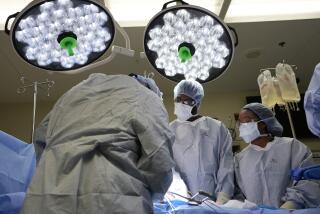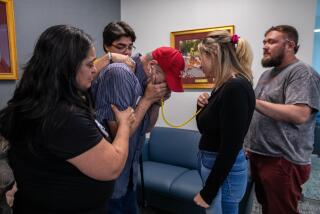Publicizing the Need for Organ Donors Keeps Schoolchildren Hopping
- Share via
The message was clear, and it came from 13 Orange County schoolchildren dedicated to helping the American Heart Assn. publicize the ever-increasing need for heart and organ donations.
“Give my heart to a person whose own heart has caused nothing but pain,” said the 7- and 8-year-old children in notes lofted skyward Friday in more than 500 red, helium-filled balloons. The balloon launch was the finale at a fund-raiser staged by jump-roping students from Primanti Montessori School in Orange and dedicated to Dr. James Mosso, a 44-year-old neurosurgeon in need of a heart-lung transplant. Mosso is the father of their classmate, Brando Mosso.
The parents and teachers who volunteered to organize the fund-raiser emphasized that the children are not collecting money to support Mosso, who is linked to an oxygen tank in his Long Beach home, awaiting a call from transplant specialists at Stanford University Medical Center.
“I didn’t even know Dr. Mosso when this whole thing started” in November, said the students’ teacher, Barbra Haiduc. “What we’re doing is for people we may never know.”
30 Jump Roping Exhibitions
The money will be donated to the American Heart Assn., which has sponsored 30 rope-jumping exhibition/fund-raisers at Orange County schools this year, according to association spokesman Dale R. Bonifield.
With the pledged donations of the Montessori school’s 13 students topping $2,000, added Bonifield, the children have done “a phenomenal thing, to say the least. We usually have an average of a hundred kids at these fund-raisers and average about $1,500.”
Bonifield said that 7-year-old Brandon Mosso’s transfer into Haiduc’s class earlier this school year “really brought everything close to home. It wasn’t just somebody else.”
Brandon’s mother, Kimberly Mosso, a resident of Anaheim Hills, said her former husband has suffered for more than three years from primary pulmonary hypertension, a disease that causes the small blood vessels of the lungs to narrow and strain the heart.
A heart-lung transplant is the only cure for the rare disease; the average life expectancy after diagnosis is three to five years.
Transplant Is Only Hope
After his diagnosis, James Mosso continued his neurosurgical practice out of offices in Long Beach and Torrance, but when he contracted pneumonia about a year ago he was forced to retire. Then doctors told him that the transplant operation is his only chance for survival.
“It’s basically a waiting game,” said Kimberly Mosso, who remains the ailing doctor’s close friend.
Because he is a doctor, coping with his illness “has been made tougher mentally because he is more knowledgeable of the negative possibilities,” Kimberly Mosso said. “He’s keeping a diary now, which is something he’s never done, to provide detailed information in case he doesn’t get the transplant.”
Ironically, neurosurgeons are often involved in determining if a patient is brain dead, a condition that legally allows relatives to consent to donate the patient’s organs, she said.
Last year surgeons at Stanford’s medical center--the only facility capable of heart-lung operations on the West Coast--performed 11 of the operations. So far this year, the hospital has not been able to do any.
“It’s all because of a lack of donors,” Kimberly Mosso said. “It’s like having pneumonia and not having the syringe to inject the cure.”
Videotaped Message
James Mosso was too weak to attend Friday’s fund-raiser, but appearing in a videotaped message, he told the children they were doing something “very special”.
“This helps to emphasize a goal of mine and of my friends to emphasize the need of organ donors,” he said.
In a telephone interview, James Mosso said that as a doctor he asked bereaved relatives to donate the organs of a loved one, often provoking disbelief and shock. He said that’s why families should decide whether to donate organs before a death in the family.
Teacher Haiduc assigned her students the task of raising the issue with their families.
“I got a lot of letters on that, some saying it was great and others who thought I shouldn’t have” made the assignment, she said.
More to Read
Sign up for Essential California
The most important California stories and recommendations in your inbox every morning.
You may occasionally receive promotional content from the Los Angeles Times.










